The next stop in my exploration of the Festival of Britain is the Pleasure Gardens at Battersea. Many of those who visited the South Bank festival site would have taken one of the shuttle boats from the South Bank piers to the pier at Battersea Park, however I had a day off work on the hottest day of the year, and caught the Circle Line to Sloane Square then walked across Chelsea Bridge to explore Battersea Park and see what reminders there are of the festival.
The Pleasure Gardens at Battersea Park were very different from the rest of the Festival of Britain events.
- All the other core events were educational and informative. The intention of the Pleasure Gardens was to balance the other events and add an element of fun to an otherwise mainly serious festival.
- The Pleasure Gardens allowed commercial sponsorship. Unlike the other events where the display of a manufacturers product was based on the excellence of the design, demonstration of innovation and a British manufacturing success, the Pleasure Gardens had a number of sponsored events and displays.
- Whilst the majority of goods displayed at the rest of the festival were British, the Pleasure Gardens sourced a number of the fairground rides from the US. The latest and most exciting rides could not be obtained in Great Britain at the time.
- You could shop at the Pleasure Gardens. The experience of shopping for luxury goods was a core part of the Battersea event.
Although the other festival sites presented a history of the land and people of Great Britain, they were essentially forward-looking – how the creativity and industry of Great Britain would create a better future – the Pleasure Gardens were more nostalgic including references to earlier pleasure gardens at Vauxhall, Ranelagh and Cremorne, traditional entertainments such as Punch and Judy and Music Hall along with gardens, water features and Rowland Emett’s Oyster Creek railway.
As with the South Bank festival, Battersea was a target of the Beaverbrook press along with much of the Conservative party who viewed the festival as a waste of money. The plan for the Pleasure Gardens was put on hold for a year, and then only went ahead with half of the budget estimated by the planners (hence the real need for commercial sponsorship).
The cover page of the guide for the Pleasure Gardens is very different from all the other official guidebooks to again highlight that the visitor would have a very different experience here than at the other events such as the main festival site, the exhibition of science etc.
Despite these differences, the focus on design was just as important as with the other sites and all the main features had an individual designer, for example:
- The Chief Designer was James Gardner, responsible for the overall design themes of the Pleasure Gardens
- The Chief Architects were D. Dex Harrison and Ernest Seel
- High Casson was responsible for the Aviary Restaurant
- Rowland Emett for the Far Tottering and Oyster Creek Railway
- Bernard Engle for the Vauxhall and Ranelagh Beer Gardens
- Arthur Braven for the Festival Fare Snack Bar
These were highly qualified people, for example Bernard Engle who was responsible for two of the beer gardens was a Fellow of the Royal Institute of British Architects and Arthur Braven, responsible for the Festival Snack Bar was an Associate of the Royal Institute of British Architects. They also designed other aspects of the festival, for example Arthur Braven designed the interior of several London double-decker buses that carried out a publicity tour of Europe for the festival.
The main areas of the Festival Gardens were:
- The Riverside along the Thames which included the pier where boats docked bringing visitors from the South Bank piers.
- The Parade – the shopping area of the Festival Gardens along with access to all the other spaces and events
- The Grand Vista – a view of towers and arcades, lakes and fountains, eating and drinking and the location of the evening fireworks
- Oyster Creek – the Rowland Emett designed railway that ran between the festival gardens stations of Oyster Creek and Far Tottering
- The Fun Fair
- Lawn and Flower Gardens
- Specific areas for children such as the Punch and Judy and Zoo
The overall view of the Festival Gardens site is shown in the following map from the Festival Guide (as usual, click on the map to open a larger version).
As with the South Bank festival site, my father took very few photos of the Pleasure Gardens, just a set of photos of one of the entertainments which I will show later, so as with the South Bank site I have been collecting postcards over the years to understand what the site looked like and I will feature some of these in this post.
Of all the festival locations, it is Battersea Park where there is still much to be seen relating to the festival. This was probably helped by the fact that many of the festival installations, such as the fun fair remained for many years after the festival closed, and Wandsworth Council have also carried out some excellent restoration work to some of the festival locations.
The main information plaque in Battersea Park recalling the festival:
I took along a copy of the guidebook to help understand the site, probably the first time it has returned to Battersea Park since 1951.
Referring back to the map of the site, I will start at the large round tent just to the lower right of the top staple. This is the Dance Pavilion.
The external appearance of the Dance Pavilion was of yellow and brown canvas, but on entering the pavilion a more sophisticated sight greeted the visitor where a second layer of canvas was hung from the central pole on which was also mounted a large chandelier. The Dance Pavilion was apparently the largest tent of its type in Europe at the time.
The dance floor was made out of oak strips surrounded by a red carpet. There was an orchestra stage and along the walls of the pavilion were alcoves. The majority of the lower surround of the pavilion was of glass.
There was space for 400 couples on the dance floor and 700 spectators on the surrounding red carpet. Regular dances were held, but it was at night when the chandelier lit up the pavilion that, in the words of the guide “the pleasures of the night are afoot”.
The Dance Pavilion:
Although there is no sign at the site, by checking the map against the physical features that still remain, the location of the Dance Pavilion seems to where this circular raised flower bed is located today.
Just to the right of the Dance Pavilion, is the Fountain Lake. This was part of the Grand Vista that ran from the Parade through to the Fern House and firework platform and formed a long view with water features on either side.
The intention with the Grand Vista was to emulate the visual effects seen in the parks surrounding English country houses, or along the processional vistas of Paris and within the grounds of Versailles. Battersea was on a much smaller scale and importantly, cost, but still produced a dramatic effect.
Designed by John Piper and Osbert Lancaster, the Grand Vista was approached from the Parade. Firstly, two great flights of steps led down to the area where two rectangular lakes each 100 foot long and containing fountains, with the visitor walking along the central walkway between the two lakes.
On either side of the lakes were Gothic towers, arcades containing shops and cane-work statues.
At the end of these two lakes was Fountain Lake. A single lake with central and side fountains that led down to the Giant Fern House and the Firework platform.
View of Fountain Lake:
The rectangular lakes, arcades and Gothic towers leading up to the Parade:
Circular feature at the end of the arcades. The round tent at the back of the photo is one of the Vista Tea Houses, blue and white umbrella roofed and where tea and coffee could be purchased.
The main features of the Grand Vista and Fountain Lake are still to be seen today. The following photo is looking back towards the Parade from the end of the Fountain Lake. Central and side fountains still play across the lake and to the left and right are round structures of poles that mark the positions of the circular structures at the end of the arcades in the original festival (see the photos above).
What I really like about the lake is the surrounding fencing at the top of the lake. I suspect this was installed as part of Wandsworth’s refurbishment of the site rather than original, however the style is perfect for the Festival of Britain.
The central fountain features also look to have been restored to as they were with a concrete base to the central fountains, and the edges painted in blue and white stripes.
View of the twin rectangular lakes leading up to the Parade. As well as the circular structures the four box structures mark the positions of similar installations during the festival – seen in the original photos above where they had cones mounted on the top of each box.
Looking up towards the flights of steps leading up towards the Parade. Note the diamond patterns on the central walkway – identical patterns can be seen in the original photos.
And a final view of the Grand Vista from the top of the stairs. This would have been the view that met the visitor, however at the time of the festival, there were Gothic towers, arcades, statues all lining the water features and at the far end a large fern house. It was also from the far end that the nighttime firework displays were launched.
Wandsworth Council have done an excellent job in restoring this part of the Pleasure Gardens, and whilst the majority of features have long since disappeared, walking along the Grand Vista and Fountain Lake does provide a sense of what the Pleasure Gardens must have looked like in 1951. Today, the lakes provide a perfect location for Londoners to sunbathe on very hot summer days.
One feature that has long since disappeared is the Far Tottering and Oyster Creek Railway.
This was one of the nostalgic features of the Pleasure Gardens. The railway had started as a cartoon series in Punch by Rowland Emett, but was created as a working, 500 yard miniature railway taking visitors from one side to the other of the Pleasure Gardens. Three trains from the cartoons called Neptune, Wild Goose and Nellie ran between the stations on a single track.
The guide to the Pleasure Gardens includes a description of the trains that illustrate the imagination and fantasy of Rowland Emett’s work:
“One thing this certainly won’t do justice to is the locomotive Neptune brought here specially for the nautical section of the railway. Even the directors are not quite clear about its origin but believe it was built from the wreck of the Packet Boat ‘Comet’, (she foundered – do you remember? – on a barnacle off Star Fish Point in the year eighteen hundred and what’s it). Measuring 10 feet to the funnel and 20 foot length with tender, Neptune is tough enough still to pull a train of 8 coaches with 12 passengers in each.
Wild Goose is another fine bird which has been pressed into similar service. She is, I understand, the railway’s reply to British Railways air services; owing to abnormal loads being carried at Battersea, however she may have difficulty in taking off.
There is also Nellie, whom nothing daunts. After all this it’s hard to realise seriously that these three locos can provide a two minute service, pulling a thousand passengers an hour.”
The Far Tottering and Oyster Creek Railway was one of the most popular attractions at the Pleasure Gardens.
Whilst concentrating on the fantasy nature of the railway, the guide also states “For the interest of the technically minded (but don’t tell Emett) the engines are diesel electrics and the track 15 inch gauge”.
The Parade at the Pleasure Gardens ran the length of what is now Carriage Drive North.
Along the parade, there were many decorative structures and features along with a range of shops. The guide stated that along the Parade “is to be found the Bond Street of the Gardens – shops whose very names spell quality and luxury.
Here you will find exquisite antiques, figures in porcelain and ivory, miniatures and elegant fairings of a past age as well as modern pottery and china of all kinds.
Here, too, are bright adornments for my lady – earings and necklaces of pearl and brilliants, costume jewelry of every description. And while madam yearns over gems and fine perfumes, elegant slippers and diaphanous underwear, the mere male can can comfort himself with the contemplation (and purchase) of pipes, snuff, fountain pens, cameras, watches or razors, while younger members of the family gape at miraculous toys, stamps (including the special Festival issue), and other wonders”.
Looking down the Parade in 1951:
The Parade today:
The Tree Walk, a raised walkway among the tops of the trees ran across the Parade.
Commercialism and sponsorship was one of the main differences between the Pleasure Gardens and all the other festival sites and events. This was essential to the Pleasure Gardens due to the very limited budget allocated for the site and could be justified as the aims of the Pleasure Gardens were very different from the rest of the Festival of Britain.
After the war, and post war period of rationing and austerity, the availability of products such as those on sale at Battersea must have seemed remarkable and if you can ignore the gender assumptions in the text from the guide, the use of words such as yearns, gapes, miraculous and wonders, as well as the reference to Bond Street are indicative of the wide spread retail commercialism of the decades to follow the 1951 festival.
The adverts within the guide to the Pleasure Gardens are also different to the other guides.
In the Pleasure Gardens guide are adverts from the sponsors along with adverts for luxury goods:
Sponsors included Guinness and their advert in the guide included a picture of the Festival Clock – their sponsored exhibit at the Pleasure Gardens.
Which could be found along the Parade:
Other sponsors included:
- HMV – the Music Pavilion
- Franco Signs – the Tree Walk
- Leichner – Powder Room
- Lockheed Hydraulic Brakes – the Mermaid Fountain
- Nestle’s – Playland and Fountain Tower
- London Zoo and News Chronicle – the Children’s Zoo and Aviary
- Schweppes – the Grotto
- Sharp’s Kreemy Toffee – Punch and Judy and the Macaws
There were also three beer gardens, named after original London pleasure gardens, Vauxhall, Ranelagh and Cremorne, that were sponsored by the Worshipful Company of Brewers.
The sponsors took full advantage of advertising and selling their products during the festival. At the Ladies Powder Room, “Leichner, having added lustre to the beauty of nearly four generations of stage stars, here offer facial magic to ordinary mortals. In the dove-grey salon with its twelve mirrored dressing tables, the ladies, in their pause for beauty, will find a full range of powders, lipsticks, eye-shadows in all the colours of the spectrum and cleansing creams and lotions”.
In the Powder Room, advice was free, but “if you wish to be expertly made-up by one of Leichner’s Young Ladies, there is a small charge”.
The restoration work by Wandsworth Council includes these structures which run parallel to the Flower Gardens. Again I doubt these are original, however the styling is perfect for the Festival Gardens, including the small fence.
Plaque commemorating the Pleasure Gardens:
A couple of other photos of the Pleasure Gardens. Many of the structures were temporary, constructed with canvas, but all highly coloured. I have not found any colour postcards of the Pleasure Gardens however some of the films I provided links for in an earlier post include colour film of the Pleasure Gardens and show a brightly coloured site, decorated throughout with bold colours.
The Crescent on the far western edge of the Pleasure Gardens:
The Pleasure Gardens also had a boating lake, just to the right of the Fun Fair and marked as number 30 in the map of the site. From the photo below there looks to have been a model village built around part of the boating lake:
Walking from the Grand Vista, back along the Parade, the site shown in the photo below, to the west of the Pagoda, was the site of the Riverside Theatre where shows were given by Britain’s leading puppet-makers, including names such as The Hogarth Puppets, Walter Wilkinson’s Hand Puppets along with Eric Bramwell and the Stavordales.
There was also plenty of entertainment for children, including the Zoo, a Peter Pan’s Railway, the Nestle’s Playland and Punch and Judy.
It was at the Punch and Judy that I found the only photos that my father appears to have taken at the Pleasure Gardens. He took a series showing the expressions of children watching one of the shows. After originally scanning these negatives, I was not sure of the location, however in one of the shoe boxes containing photos he had printed, I found one of these photos with the location written on the back.
In the guide book there is a drawing of the Punch and Judy showing the railings around the seating area and benches which are the same as in my father’s photo. The drawing also gives an impression of what the children are looking at:
The Punch and Judy was at location 13 on the Pleasure Gardens map. It was located along the Parade which is also lined with large trees. I have no idea how long these particular species of trees take to grow, but they look large / old and on the assumption that these are the same trees as at the festival, or later trees planted in the same places, I counted the number of trees from the entrance to the Grand Vista in the map and along the Parade today which took me to the following spot, which if correct, the Punch and Judy was in the space to the left of the bench.
The Mermaid Fountain (sponsored by Lockheed Hydraulic Brakes) was on the space currently occupied by the Pagoda.
Further along is the entrance to the Children’s Zoo. Originally, this was further back, to the east of the Flower Gardens, but has since expanded to take up the space occupied by The Piazza.
The Zoo at the time of the Pleasure Gardens had two bear cubs called Ruff and Scruff along with baby lions, foxes, wallabies and a crab eating racoon with the unusual name (for a racoon) of Sally.
There was a cage with monkeys, a “Mousetown building where hundreds of mice perform their antics all day long”, a llama, goats, sheep, rabbits, guinea pigs, hamsters and tropical fish and a reindeer called Rudolph.
The original entrance to the Piazza, now the entrance to the Zoo is shown in the photo below:
The commercial aspects of the Pleasure Gardens extended to children. The Nestle’s Playground was advertised with the text that “Nestle’s have immense experience at looking after children and making them happy.” When the parent collected their children at the end of a two hour session at the Playground, each child was given a present, which I am sure was Nestle’s branded.
The other main attraction area of the Pleasure Gardens was the Fun Fair.
The Fun Fair was probably the most controversial of the Pleasure Gardens entertainments. For the previous 12 years, the development of fun fair rides has been the last thing in the mind of British industry. The American fun fair business had continued almost without interruption and new rides had been developed with height and speed increasing their excitement and attraction to visitors. There was nothing available in Great Britain that could hope to bring visitors the level of excitement expected from such a one off event as the Festival of Britain.
The organisors of the festival therefore decided to go to America and purchase rides for use at the Pleasure Gardens. The Treasury agreed a sum of £30,000 (a significant sum at the time – even more so considering national prioirties) to spend on rides from America and a team traveled out to select and purchase suitable rides (the team included representatives from other British fun fairs as the intention was to help justify the purchase, the rides would be sold to other British fun fairs after the festival had closed).
The Beaverbrook press found out about the visit and the budget with the resulting Daily Mail headlines criticising this waste of national funds.
As a result of the visit, the Festival Gardens ended up with some of the latest American fun fair rides, which including the small number sourced from Great Britain provided the fun fair with Three Abreast Gallopers, Lighthouse Slip, Leaping Lena, Octopus, The Whip, Dodgems, Caterpillar, Waltzer, Moon Rocket, Big Dipper, Scenic Grotto, Peter Pan Railway, Ghost Train, Bubble Bounce, Hurricane, Fly-o-Plane, Rotor, Boomerang, Flying Cars and the Sky Wheel which would carry riders 90 feet into the air. I am not sure of the type of ride of all these, but it does sound as if the visitor would have had a good time.
Parts of the fun fair continued long after the Festival Pleasure Gardens closed – a story for another time.
The Pleasure Gardens after dark were one of the main attractions for visitors. Whether the chandelier lit dances in the Dance Pavilions, the brightly lit shops, the Fireworks, the lighting on all the main features and the lakes and fountains, it was a very different experience for those who had lived through the long years of war and post war austerity.
Rockets and fireworks could be seen launched from the end of the Grand Vista or from on the lake. The trees along the Parade were lit by sodium and mercury lighting concealed on the roofs of the shops that lined the Parade. Fairy lights and multi-coloured diamond lights lit the pier on the river. Far Tottering station was lit by bright platform lights and above the Children’s Zoo a huge lighted bird was placed above the aviary whilst fairy lamps light the pony rides below.
All the individual shops, restaurants, cafes and bars had their own individual lighting scheme.
It must have been quite an experience to walk the Festival Gardens at Battersea after dark.
The Pleasure Gardens were very different to the rest of the Festival of Britain exhibitions, although they did share the same aim of bringing – in Gerald Barry’s words – “elegant entertainment” to the masses and creating a classless environment where different and new forms of entertainment were open to all.
The Pleasure Gardens aligned with the Labour Government aim of trying to broaden the types of entertainment enjoyed by the majority of the British population, which an earlier Labour report had identified as being too dependent on pubs and the cinema. There was also concern with the population being too dependent on passive forms of entertainment, and the creeping Americanisation of entertainment (despite the purchase of fun fair rides from America).
The last section in the guide to the Pleasure Gardens quotes Dr Johnson’s description of Vauxhall Gardens, suggesting that the description could well apply to the Pleasure Gardens at Battersea:
“That excellent place of amusement…is particularly adapted to the taste of the English nation, there being a mixture of curious show, gay exhibition, music, vocal and instrumental, not too refined for the general ear…and though last, not least good eating and drinking for those who choose to purchase that regale”.
The Pleasure Gardens at Battersea were a great success during the Festival of Britain, however as with much else portrayed across the Festival of Britain, the ambition of bringing “elegant entertainment” to the majority of the British population would take a very different path in the decades that would follow.
Battersea Park is well worth a visit (although perhaps not on the hottest day of the year) and Wandsworth Council have done a good job with the restoration of the area around the Grand Vista, Fountain Lake and Flower Gardens and features such as the railings really do evoke the designs from 1951.
Next week is my final post on the Festival of Britain with a visit to the Exhibition of Architecture at Poplar.

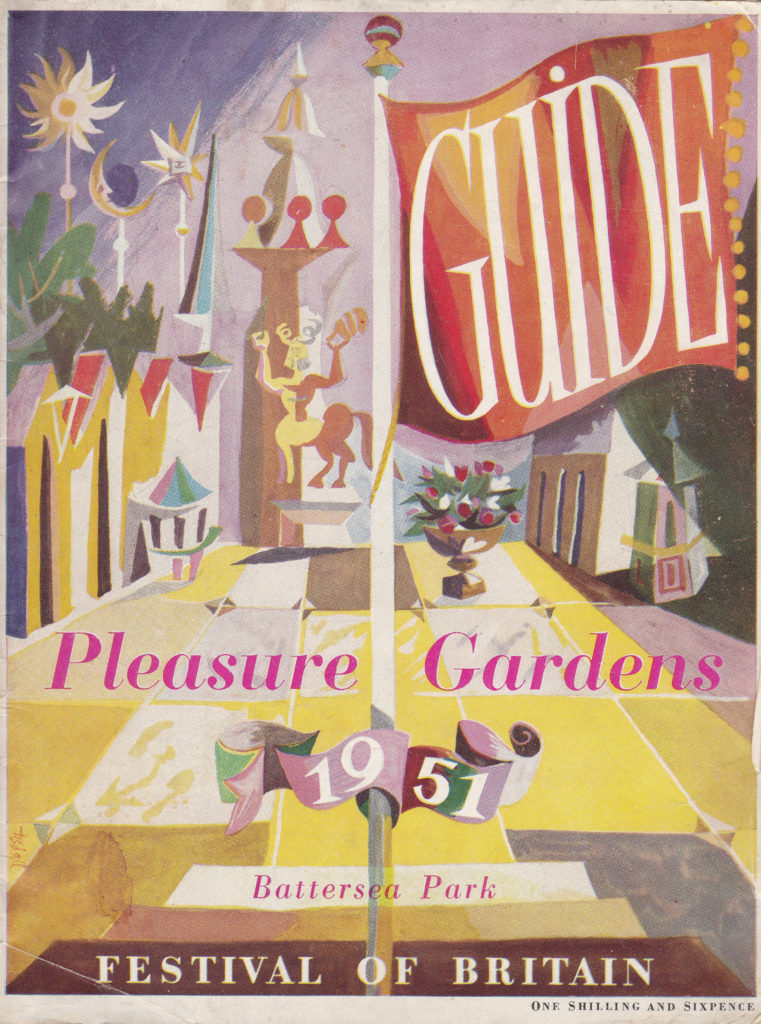

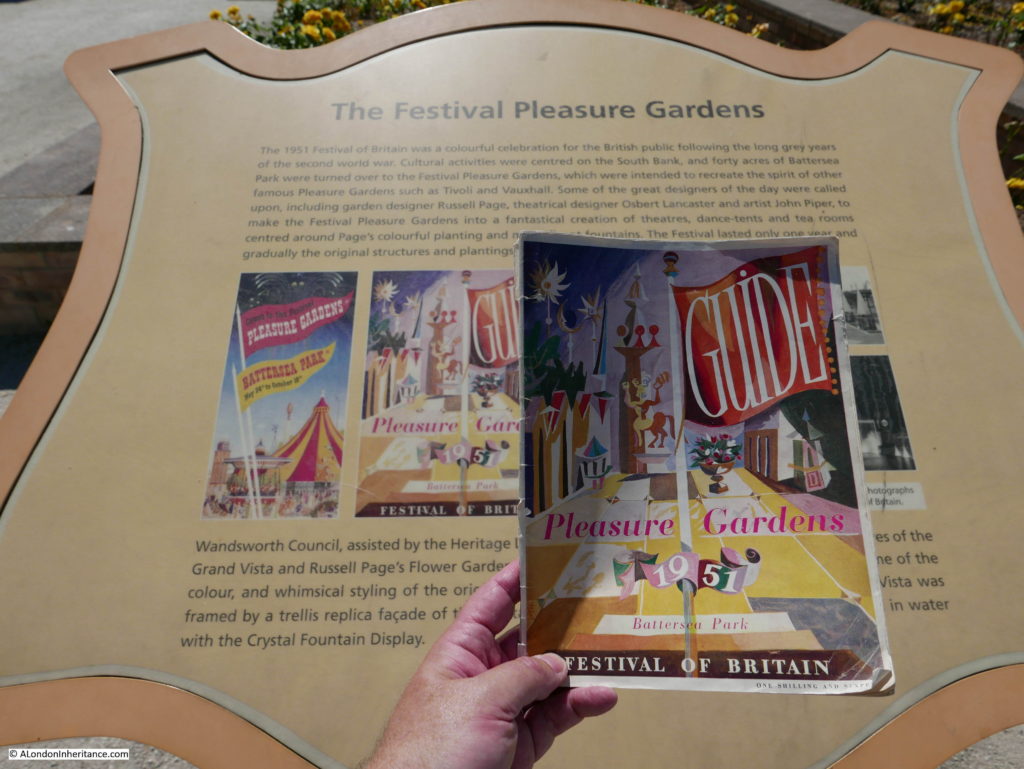





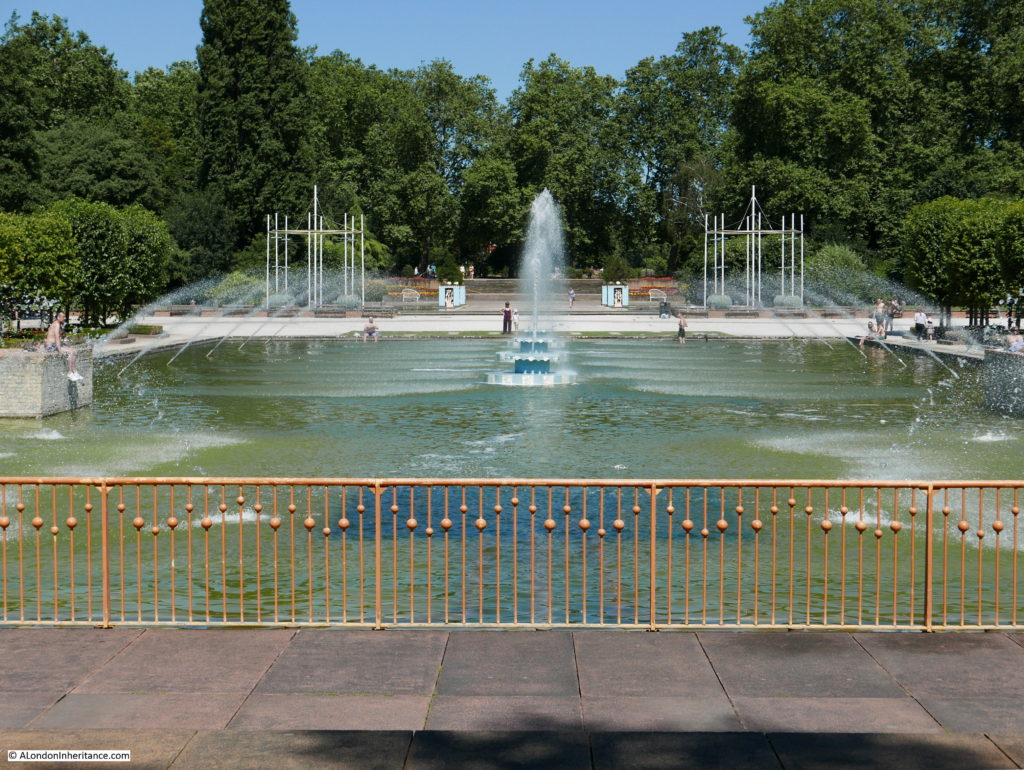
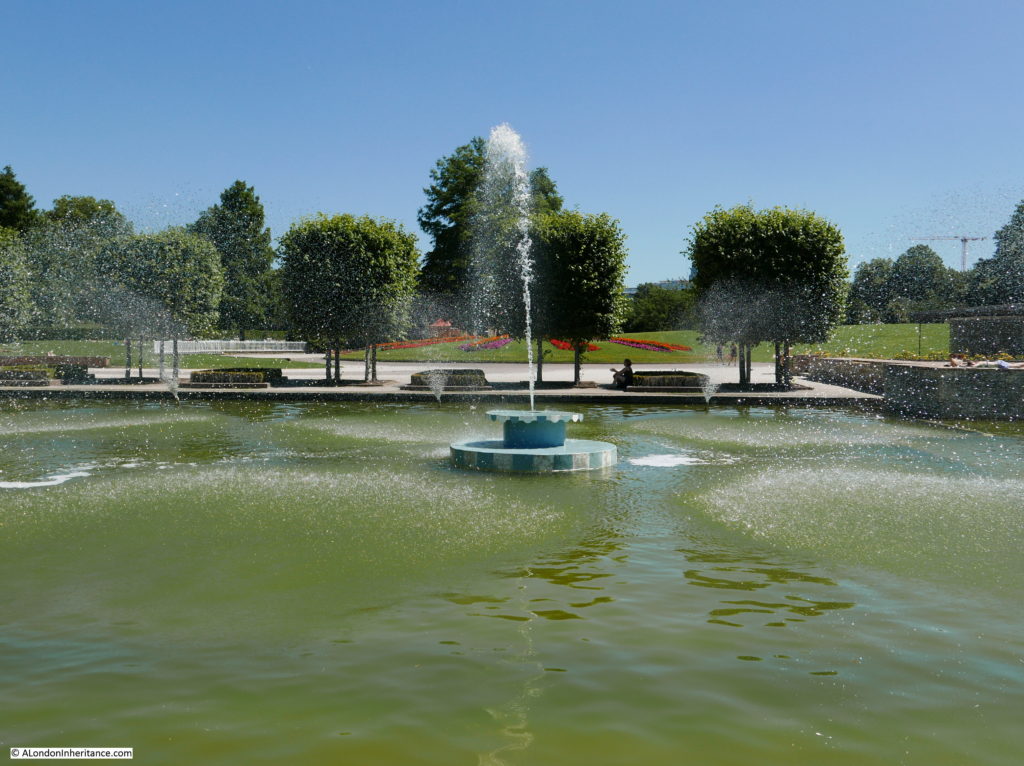
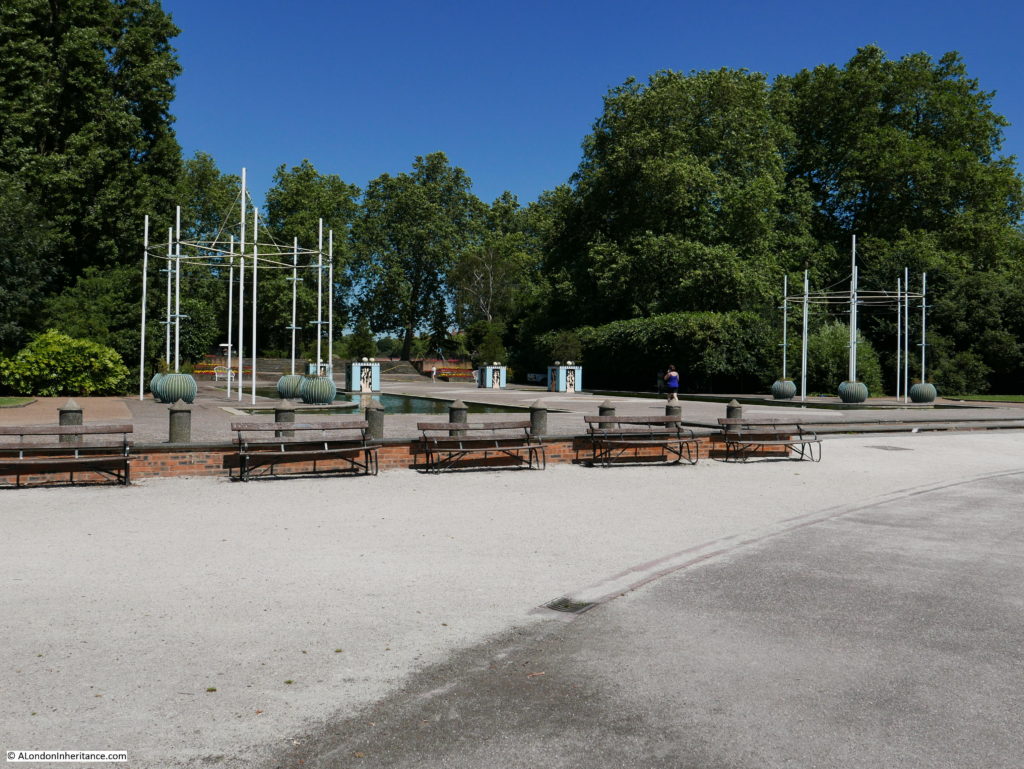

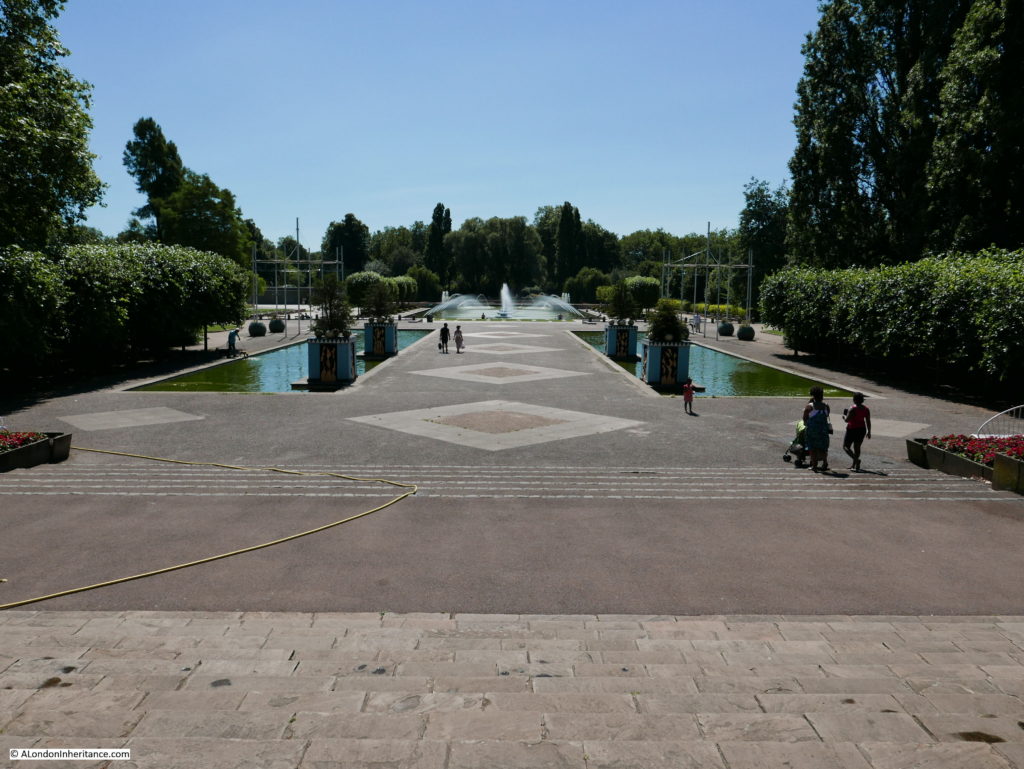
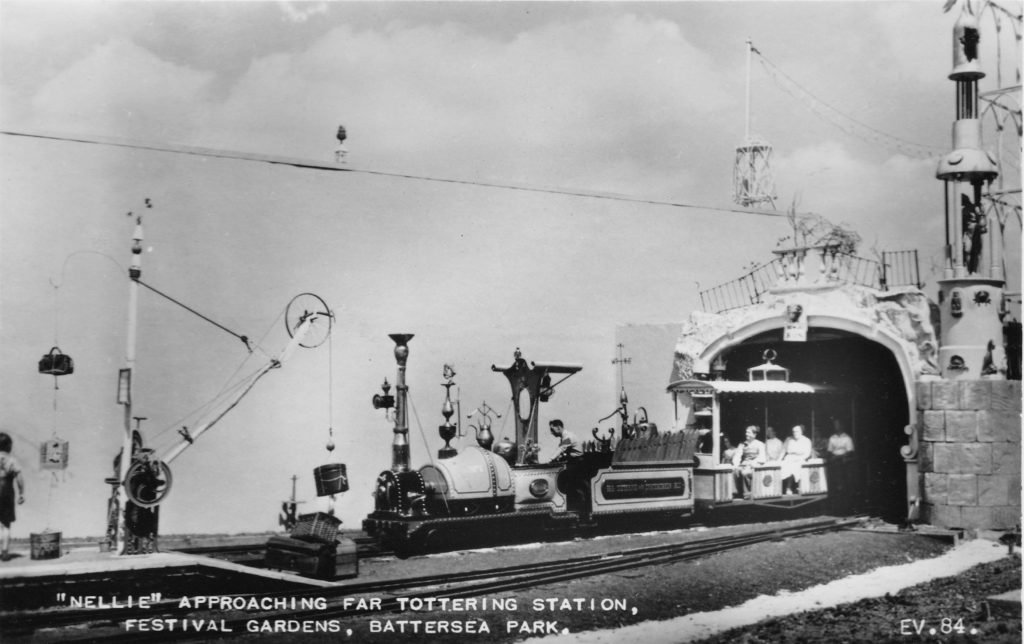
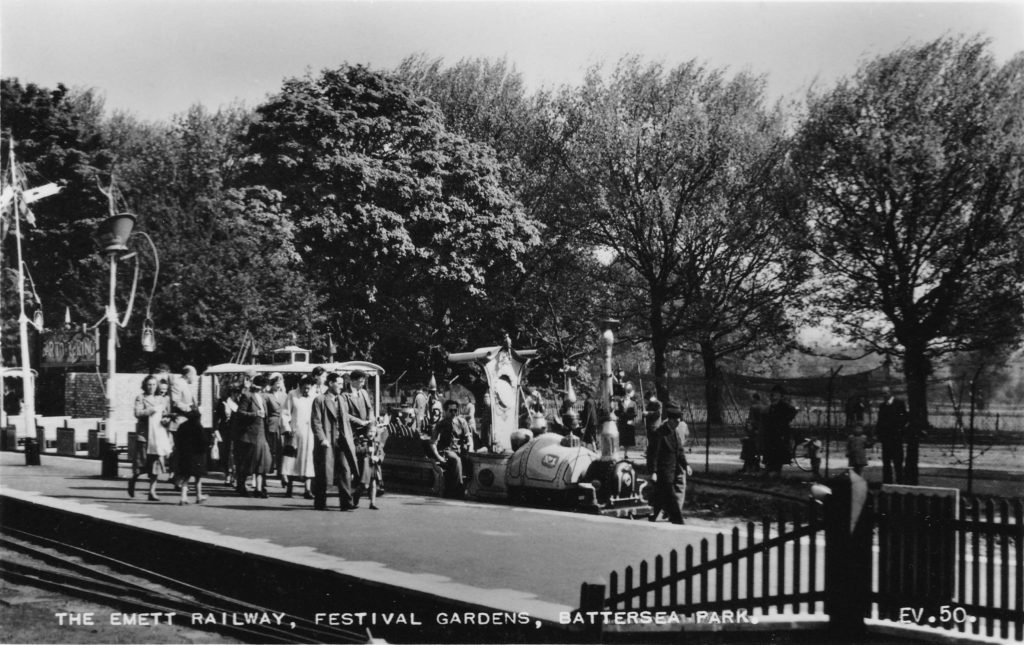
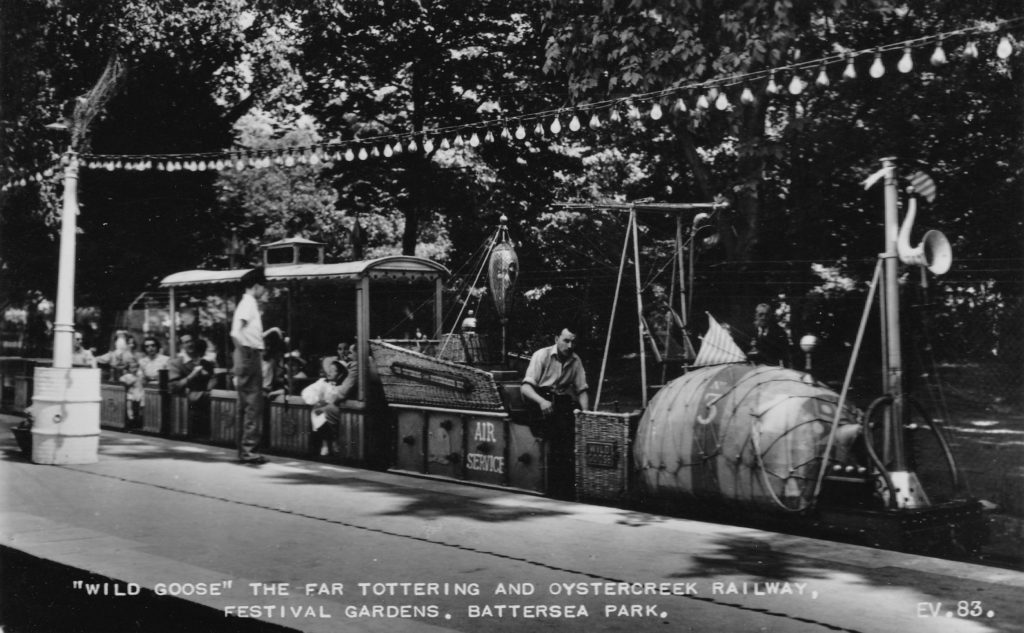
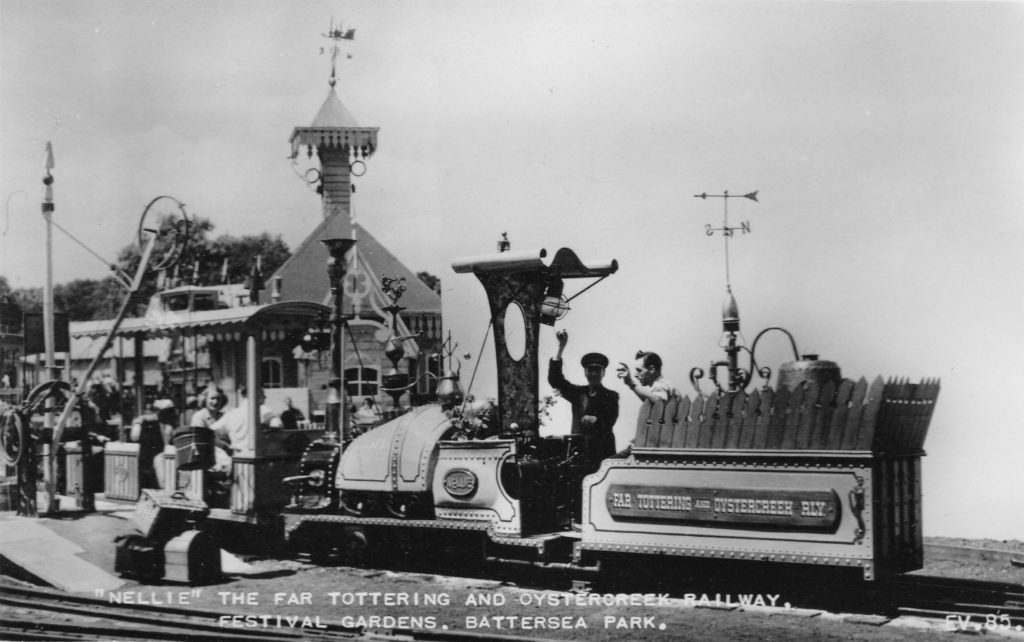
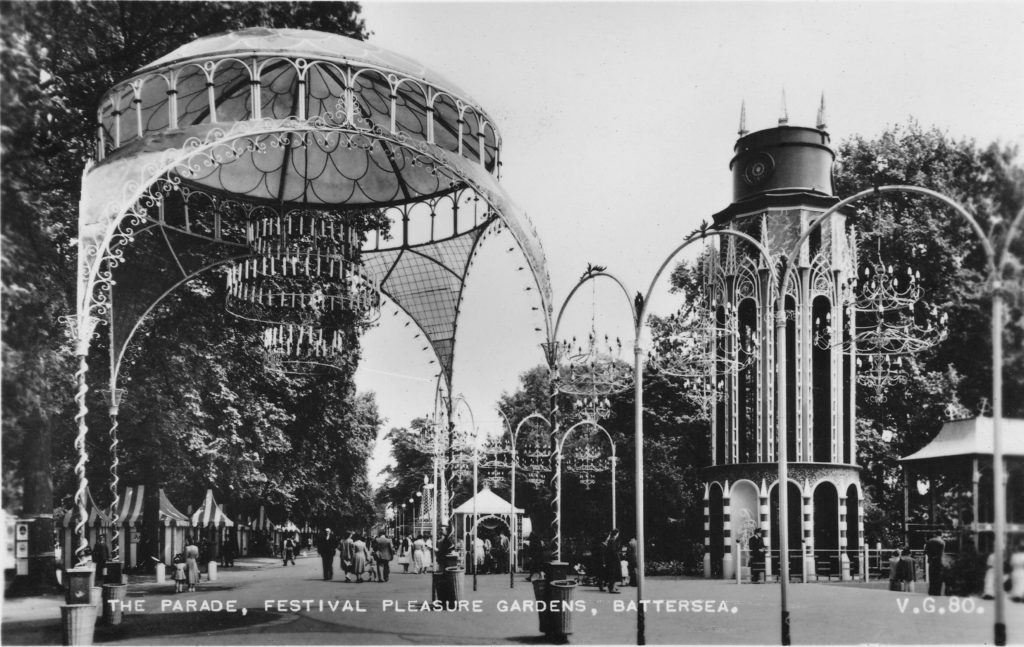

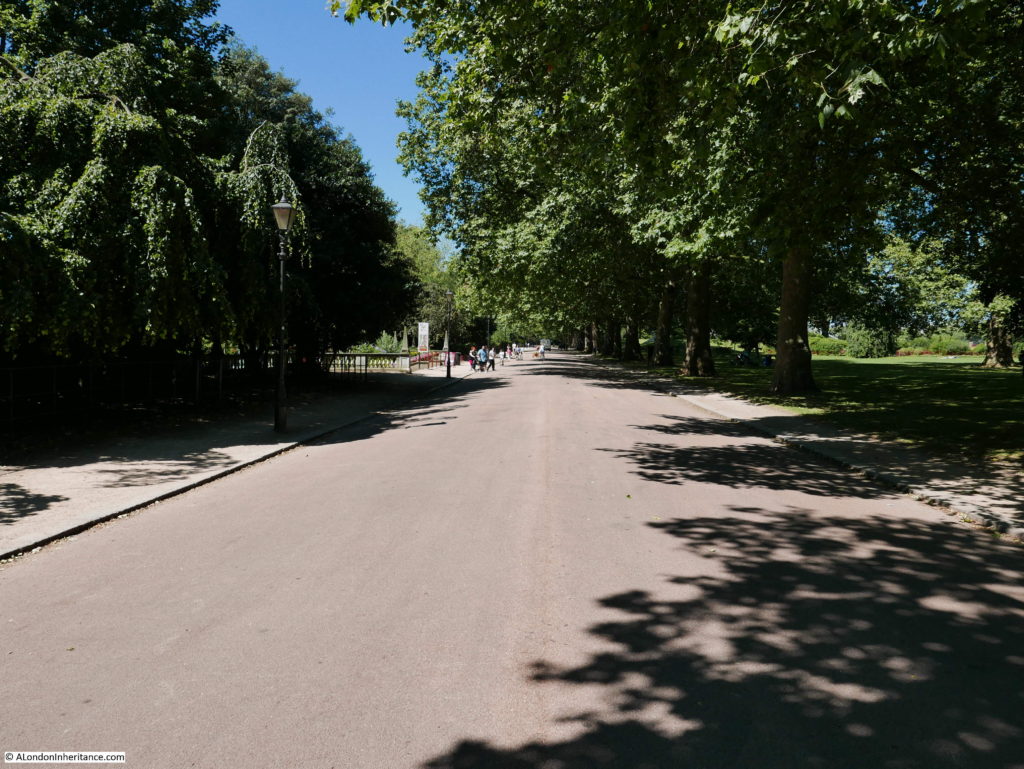
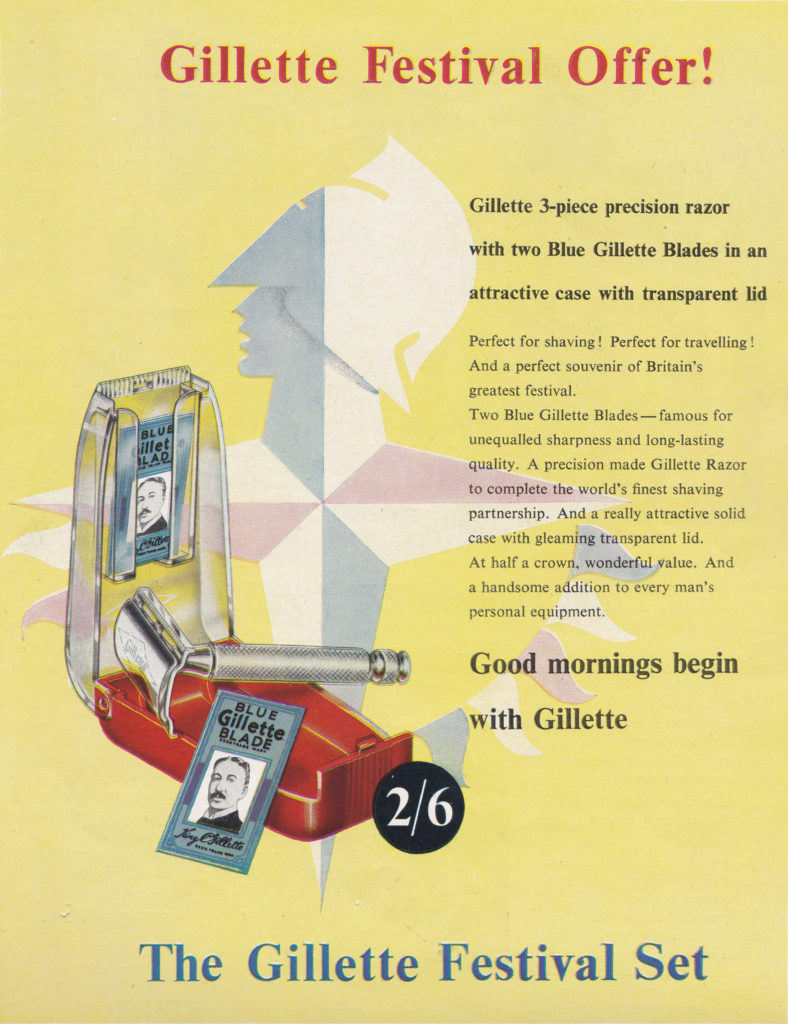


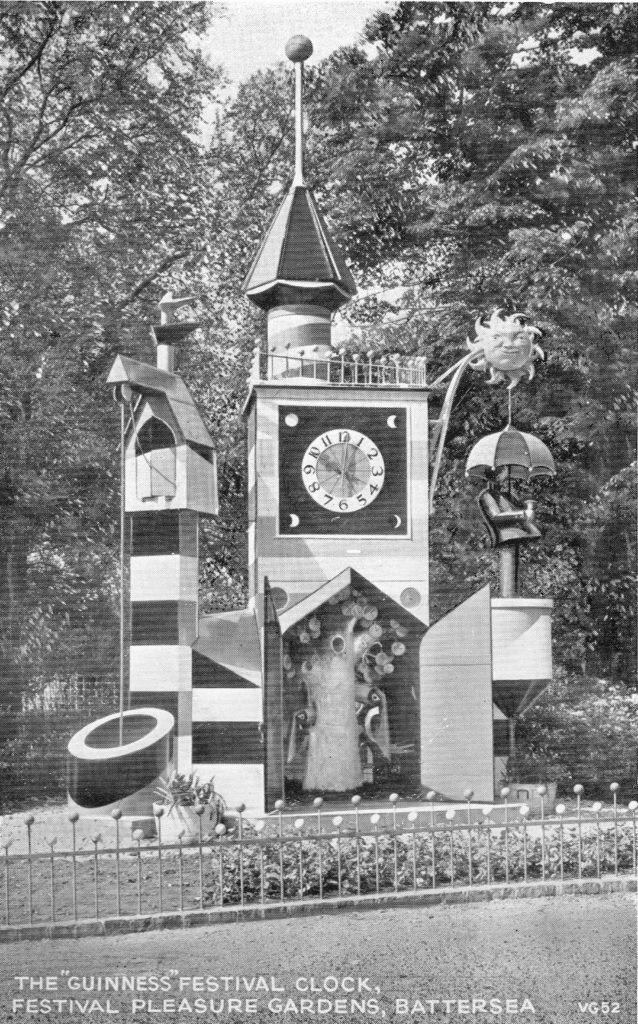

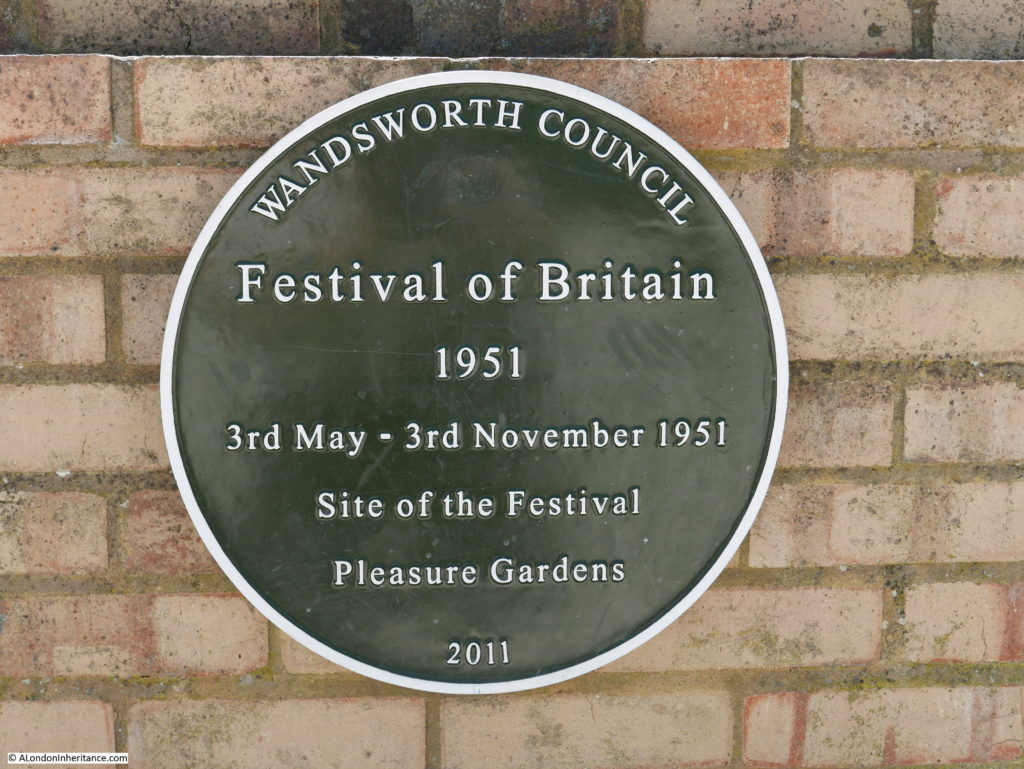

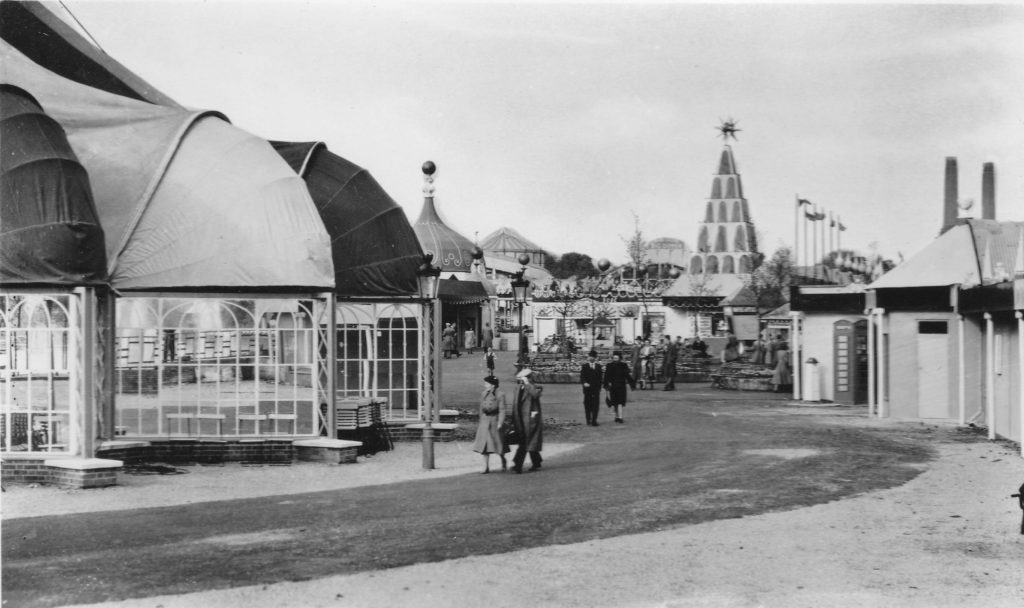


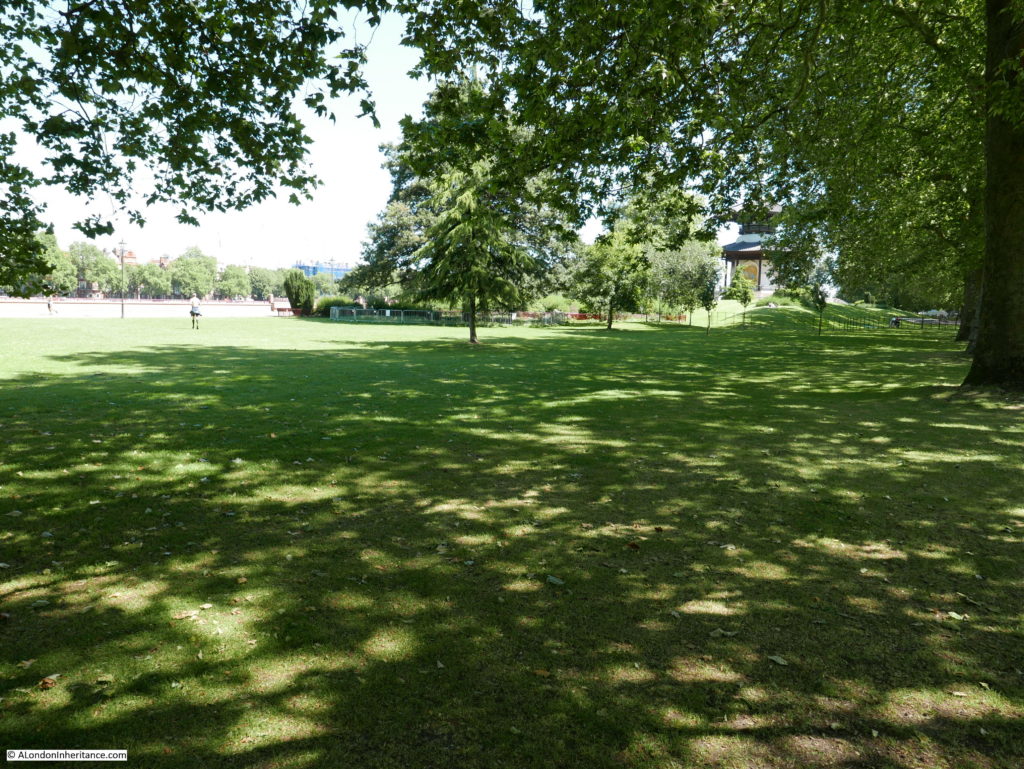

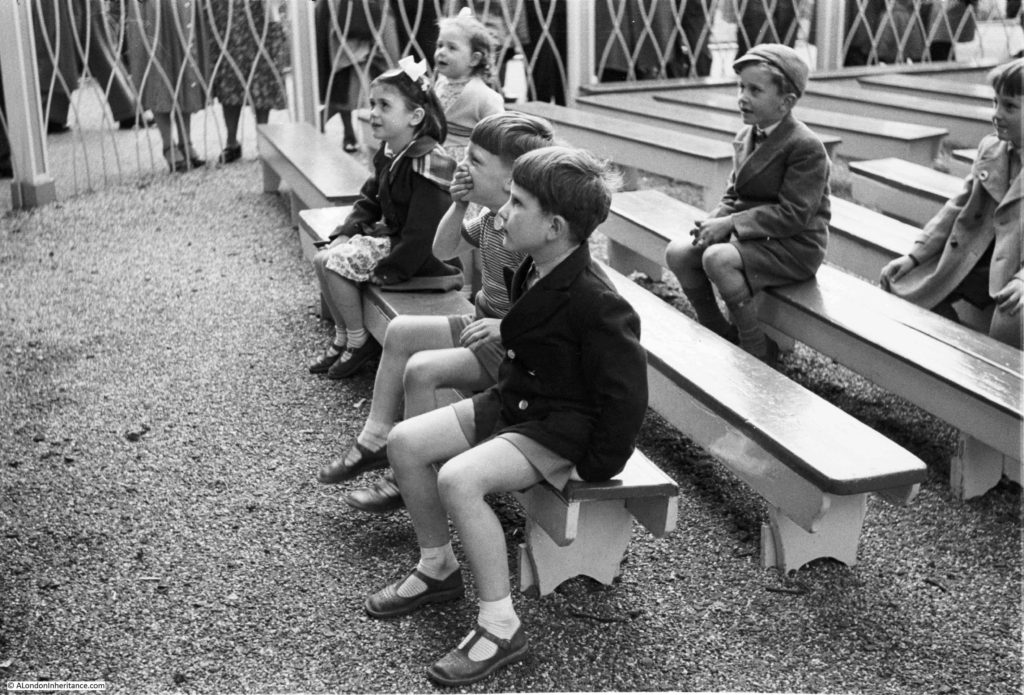
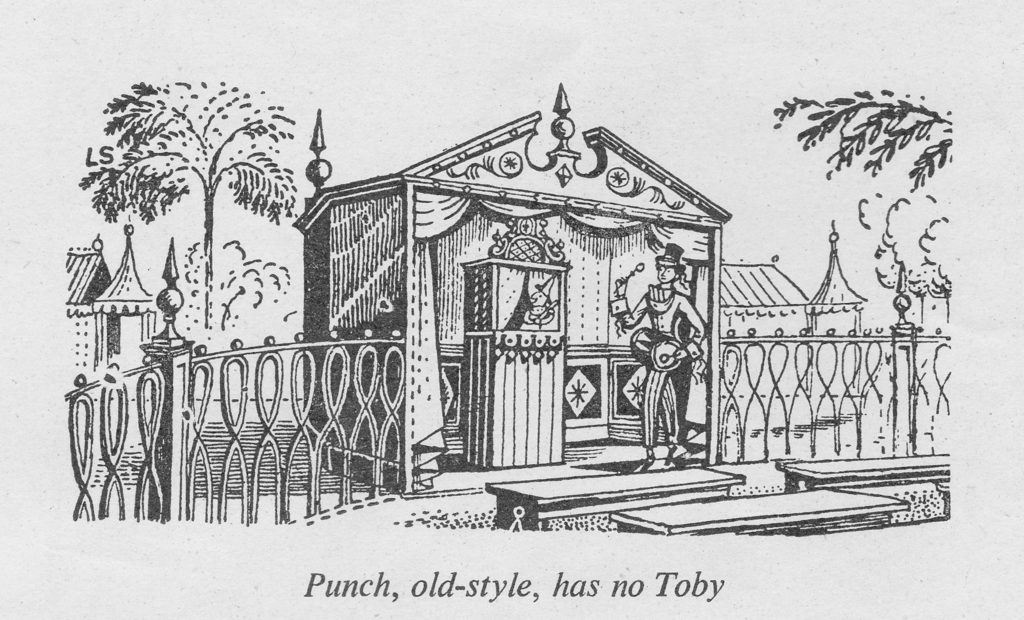
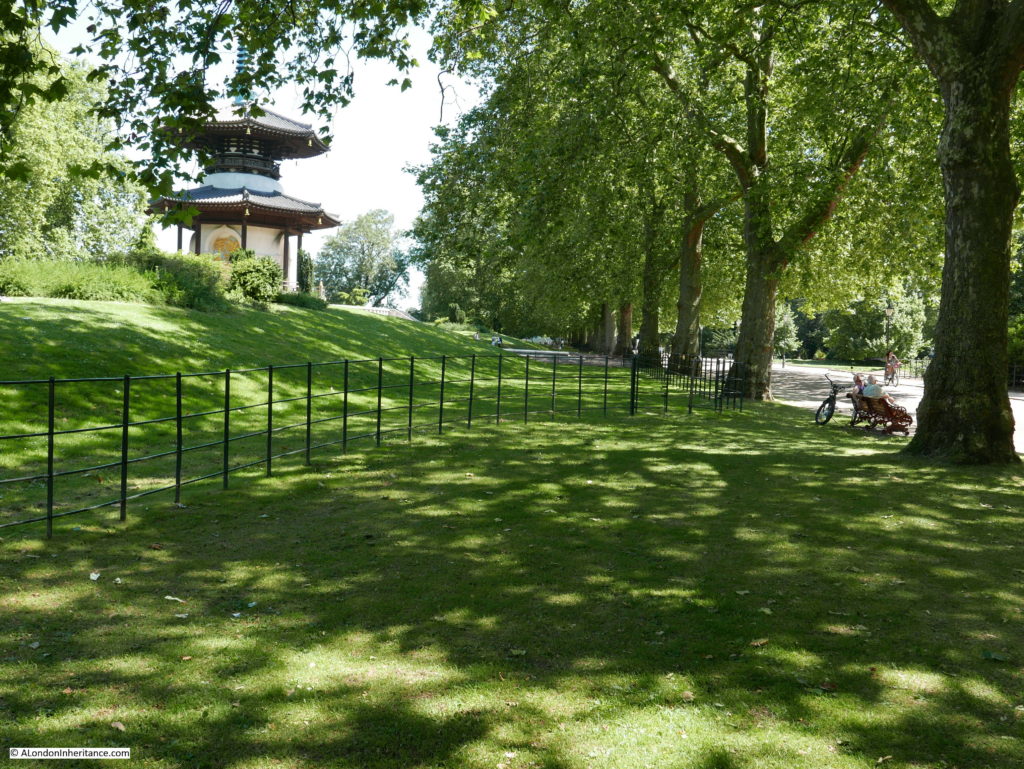
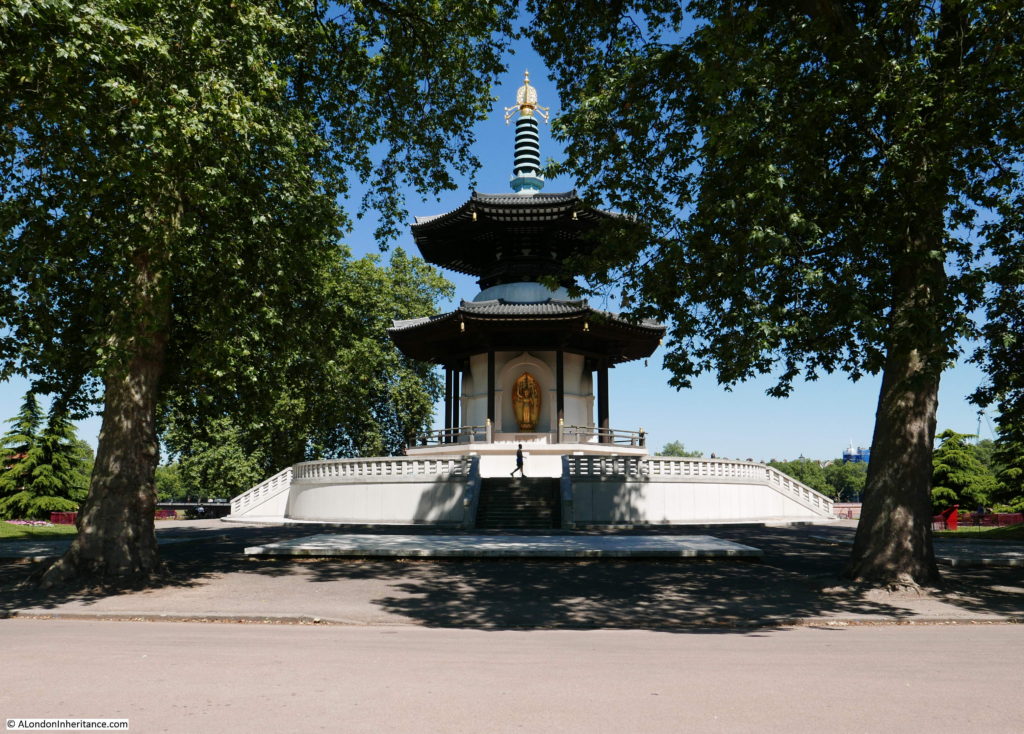
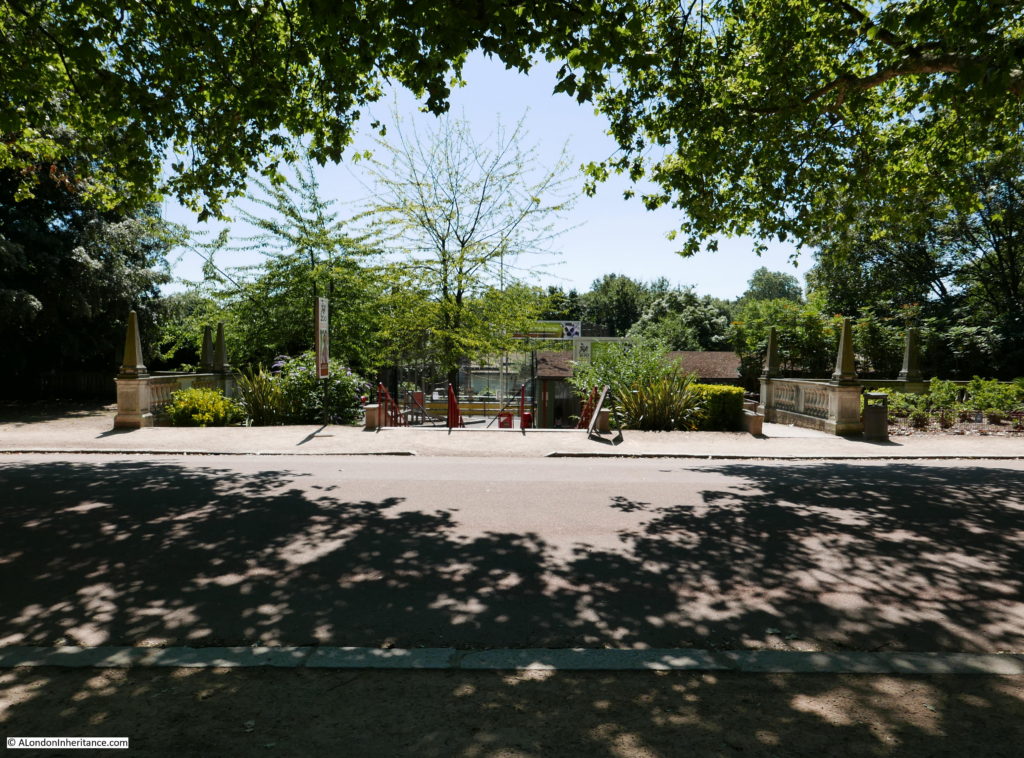
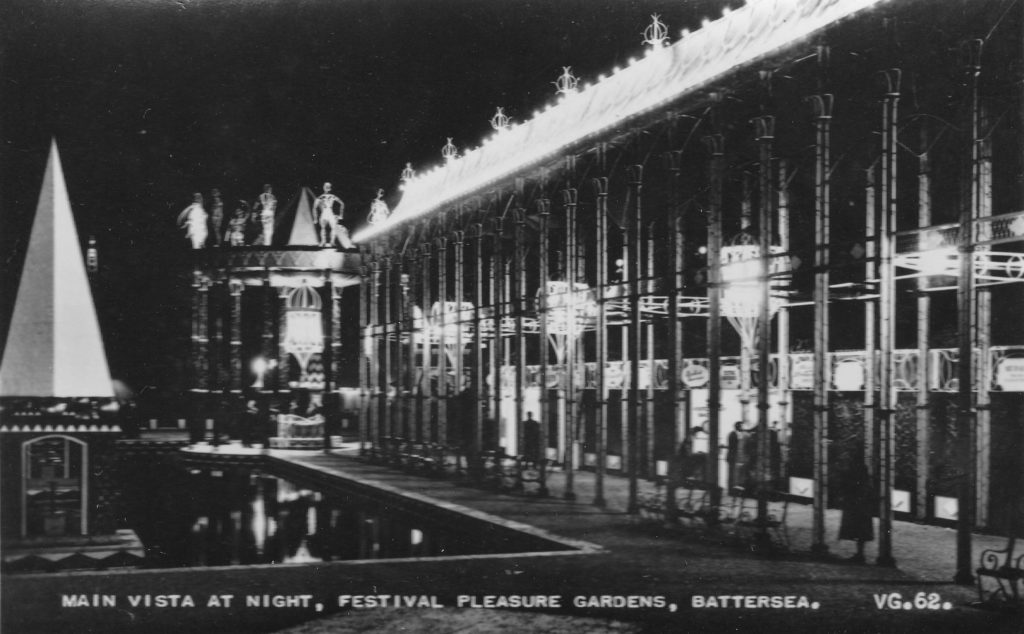
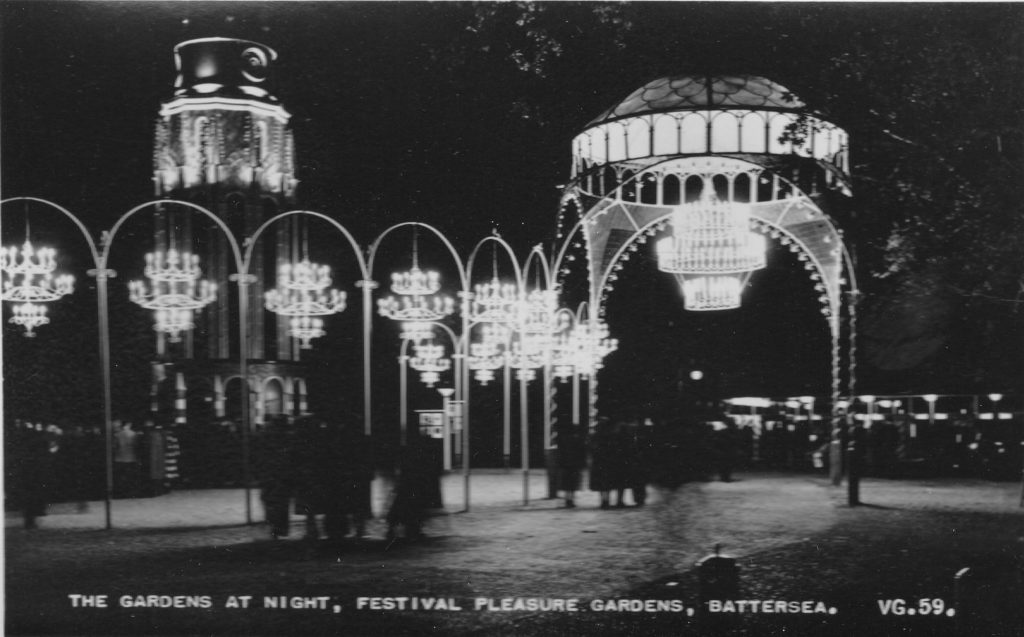
Another excellent posting. Many thanks.
This continues to be brilliant. I have always been sorry that I was born too late to visit the Festival of Britain – though I have photos of my parents there – but this is almost as good. Like a time machine.
Thank you Admin for so many jogs to my memory. I enjoyed the photographs of the restoration work that has been done and have added Battersea Park to our list of ‘to visit’. I never got to go on the tree walk-money wasn’t plentiful-it was that or the fair. Sometimes it was just the lake and gardens. Ho hum.
Some of the Festival Gardens hardware was still around in the late fifties and sixties. Trips to Battersea Park with parents in those years would include a stop at the Guinness Clock, the Grotto with its lingering perfume, Fountain Lake with its curious waterspouting shapes, the Tree Walk, a simplified version of the miniature railway, the Children’s Zoo (smelly at warmer times of the year) and of course the Funfair with the Big Dipper, the Water Chute, Caterpillar, Ghost Train, Dodgems, the Rotor and the Big Wheel.
The Grand Vista was the set for an ITV commercial of the early sixties. I don’t remember the product, just a joyous man and woman with what Terry Wogan might later call “serious teeth”.
I’m fairly sure, as far as distant memories can be trusted, that entrances to the park were marked as “Battersea Park and Festival Gardens” well into the sixties.
There are some excellent scenes of the Funfair and the area around the Tree Walk in the film “The Day the Earth Caught Fire”, 1961.
There was a Nissen Hut in the park beside Prince of Wales Drive. I guess this was a leftover from wartime activities.
I can remember this I went a few Times with my cousins visiting from Wales I am now 71and still have very fond memories I used to love the Guinness clock and the tree walk I remember seeing Arthur Askey the comedian there
I was probably just about 5 when we went to the Festival of Britain. Looking at this I think we only went to the Festival Gardens. I remember walking down quite steep steps and being able to see so much spread out below. I think one of the first things I saw was a stream of doughnuts travelling along to be dropped into hot fat then coming out to be tipped into sugar. My Mummy’s friend, ‘Aunty Benny’ bought us all one.
Was there a Wall of Death with motor cyclists going round?
I am not sure if it was here or the local fair that a man dived from a tall tower into a small pool of possibly flaming water.
I do recall the tree walk. Very exciting for a 5 year old.
We walked past Battersea Dogs’ Home
I think that was when we went to a demonstration and Mummy bought a pressure cooker and a tumbler with insert that whisked up eggs to make fluffy omelettes!
I know it was very late when we got back to Loughton station (I had probably been asleep in the pushchair with my baby sister) and saying it was so late it was beginning to get light again!
How I wish I could ask my parents about these things.
Such vivid memories from when you were only 5.
A long way to travel from Loughton.
Thank you for sharing.
Hi, really interesting reading all about this as my Grandad Ernest Seel was it appears one of the lead architects. I knew had designed ‘something at the Pleasure Gardens’ but it sounds like, with his partner, he must have had a hand in a lot of the buildings? I was wondering if your programme lists who designed each part? Any info would be of great interest.
I didn’t see it on your post but I think the bandstand is still there, do you know if thatis the only original structure left over from the Festival? Apart from landscaping. I might well call in next time on town to see what he built. Thanks if you can direct me to anything more on this. Nice blog generally too, like the level of research and writing. Cheers.
I remember the Grotto, the walk over the volcano and near the exit the four winds, with sound effects through a speaker. The north wind was a blue statue of a viking and the east wind was a quiet Oriental gent in the corner. Very eerie. Can’t remember the west or south wind statues or what was at the entrance. But always feel nostalgic for the funfair. Last time I was there was 1973 just before it closed. John Collins Big Dipper could still be seen up until 1980. Anyone remember the buzzer going off when the lady was knocked out of the bed and the rush of boys and men to take a look. Oh and don’t forget the octopus!!
The intro to the 1968 tv show Journey to the Unknown was shot in Battersea funfair at night.
I remember the tree walk as a small child, some years after the festival, and I might have been one of the last people to go on it. My family visited London, from the Midlands, and spent a day in Battersea. As there was nobody on the end gate of the tree walk, my parents decided to have free go. The adults climbed over the gate/fence and us children (me and my older sister) were lifted over. I remember thinking it a bit rickety, but it held my fathers weight, so I didn’t think much of it. It was an amazing, a magical experience, but it looked a little shabby with age. There were wooden cut-outs in the trees, I remember The Mad Hatter and other characters from The Alice books, so maybe they were of characters from classic British Children’s books? I wasn’t much older than a toddler at the time, so don’t remember much about it. Maybe there were lights turned off, but my memory is a bit hazy. There were still some parts of the funfair in operation.
When we got to the start we found there was a notice saying the tree walk had been condemned, and was going to be pulled down because it was unsafe. I’ve often thought it says a lot about my parents, but as nobody came to any harm, I treasure the memory. I was born in 1965, so I’d guess this was in the late 1960’s or early 1970’s. I’ve often wondered when tree walk was demolished. It sparked my interest in the Festival of Britain. I missed the Skylon, but at least I saw the tree walk.
A great web site. Have enjoyed reading this. I grew up in Battersea Park funfair when a child as my father had his Globe of Death motorcycle act there – opposite the Rotor. In the mid fiftis and early sixties he partnered the magician Robert Harbin and presented side shows: The INvisible Man/ The Spider Woman/ Varna the Jungle Girl/ The Wowl etc etc. If you go to Amazon and look up Smokestack Lightning by Laurence Staig you will find my autobiography and I have chapters in there about the funfair.
It was interesting to see Laurence Staig’s note.
I too had a connection with the park (1958 onwards). I was raised by my grandparents in West Lodge, just inside the park gates, near Albert Bridge.
My grandfather was Superintendent.
Needless to say I had a totally spoilt childhood.
My parents were divorced hence being raised my grandparents.
Saturday was dad and we always went to the Fair. Sunday was mum and it was always a Stately Home or somewhere of the ilk.
I remember one day being let lose in the old stock room in the offices there. Amongst the standard stuff, batteries for the keepers torches, miscellaneous filed telephones etc etc I found a treasure. It was a guide book to the Festival including a guide to the park. Every page was magic to a young child.
Unfortunately by that time many of the attractions had gone or been changed.
Emmitt’s Railway was no more.
The fountain’s were still there, but many of the wonderful ornate structures had been removed. The only clues to their existence being the occasional piece of ironwork visible in the ground.
My grandfather had hundreds of Kodachrome slides, including some of the original buildings (post 1951) etc. Unfortunately, all but a handful were thrown out when we moved upon his retirement.
Look forward to reading more memories and finding sources of Film from the 51/53 period
I visited the Funfair in Battersea Park as a small boy (not yet 10 years old) soon after it opened, and was much struck by going on the magical Tree Walk after dark, when it was lit and very special. To this day I recall where it was.
In the early 1970s I acquired a flat in the block just opposite the WestGates to the Park; the remnants of the Funfair – much depleted – wer eswtilloperating, but went quite soon – I understand that it finally closed in 1974.
My great auntie May worked as the cashier on the tree walk – usually at the kiosk opposite the main fairground entry. She had also been my father’s step mother and she used to ride the Globe of Death!
I was a Yank at the Festival of Britain. My Dad was in the USAF and he was stationed at Burtonwood AFB. We flew down to London from the Burtonwood airfield on a Scottish Airlines (Where are they now?) in a DC-3 converted to passenger accommodation. After Lancashire London seemed more like Morocco; the sun would often come out.
After ten years of Depression, six of war (took us Yanks long enough to get into it!) and another ten of Austerity, you blokes still “kept your pekkers up.” Good on you!
Stanley Sandler
Great piece on the history of the park.
I have an item that might be associated
With Battersea park, possibly from the
70s – 80s. The item is a 4 wheel recumbent
Racer/go kart. I am currently refurbishing
the kart which is in a rough state but has
intriguing decals that say
Battersea park Le Mans racer
Any information on the racer would be
appreciated regards
Gary.
Thank you very much for your efforts on this. I really enjoyed reading it. I was born in the 50’s and grew up living on Albert Bridge Road across from the park. I spent a LOT of my childhood in the park and fun fair. One of the things I clearly recall was the smell in the grotto. I think they must have wafted some kind of incense in there. Every now and again I will sniff a perfume or a candle or some-such and be transported back 50/60 years to the grotto!
Gosh, I remember that grotto pong very well! Also, how the UV lighting in the grotto illuminated anything white. Magical & kind of creepy at the same time. There used to be a fortune tellers booth/ kiosk locted by one of its entrances too i seem to recall
Thank you for all this detailed information. As I write a short piece for our local City of Winchester Trust about the 70th Anniversary of the FoB, your work has been extremely useful. I visited the South Bank with my parents as a 5 year old. Combined with the ride on an electric train from Sydenham where I lived, the FoB site was amazingly engaging, there was so much to see and do. I only went to the remains of the Pleasure Gardens in later years when it was just the Fun Fair left. It was all quite seedy by that time, although I did not know the real history until I started researching. The whole FoB across the nation was a superb, imaginative and creative enterprise. I have very fond and lasting good memories. You have done its legacy justice with this very interesting review and update. Thank you so much.
Joyland books have now published a book about Battersea Park Funfair:
https://www.joylandbooks.com/books_new/battersea-fun-fair.htm
I declare a small interest as I wrote the introductionas someone who grew up there when a kid, but there are a lot of photos includng a fair few of my father who worked there – well worth a look 🙂
The Riverside Rooms restaurant was still there in the early 80s but never open. Then like so many of the Festival buildings taken down.
WOW! Terrific coverage of a magnificent event. Felt like I was back in time and visiting the Pleasure Gardens. Excellent writing. I enjoyed reading this as much as any book I’ve read(Holy Bible excepted). Thanks for publishing. Blessings, Tedd, Baldwin, Maryland USA.
I am writing a piece “in search of Roland Emett” for a local not for profit magazine and would be very appreciative if you could let me use the photograph of the Emett 1951 railway picture in it .
Thankyou
I am trying to find an open air theatre in 1951. Perhaps it was knocked down
I was a young teenage dancer in a show that summer with a live band and singers .
Any idea who they could be?
I certainly remember going to the open air theatre quite often. Not sure whether it survived the closure of the fair etc
This is an excellent article. Thank you so much. I give a talk about the history of Pleasure Gardens, so I’ve been able to add information about this one as well.
My parents took me to the Festival of Britain when I was 4. My father, a keen amateur photographer took some photos which has no doubt helped to endorse my memories. I well remember the fountains with triangular glass sides in the lake and also the colourful clock with lots of moving parts and the amazing Heath Robinson type of machine which rolled down a ball or something which dropped into something else which scooped it up and along and so forth to the end.
Later when it was reduced to a funfair much to my indignation I was carried over the turnstiles so my father didn’t have to pay for me! I was about 8! I recall there was a bank of slot machines displaying awards/gifts for 6d. Unbeknown to me a 2 way round mirror above permitted the operator behind to dispatch an appropriate present. As my mother had lifted me to put the money in, they saw my mother and I was duly despatched a tea strainer! Bitterly disappointed we walked around the back to see a very small adult person on a scaffolding board balanced between oil drums who was in charge of despatching appropriate presents responding to each machine as a red light lit on receipt of a 6d. The tea strainer was exchanged for a toy. When hole in the wall cash machines were introduced in the 60’s it was hard to dispel this early childhood image in favour of automation!